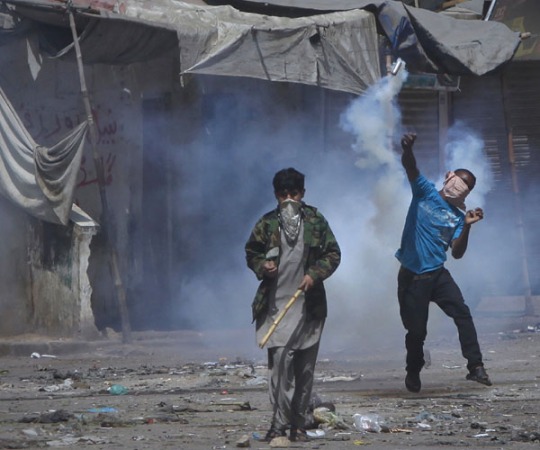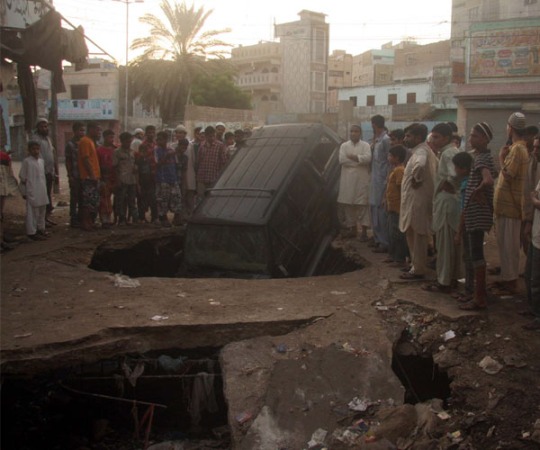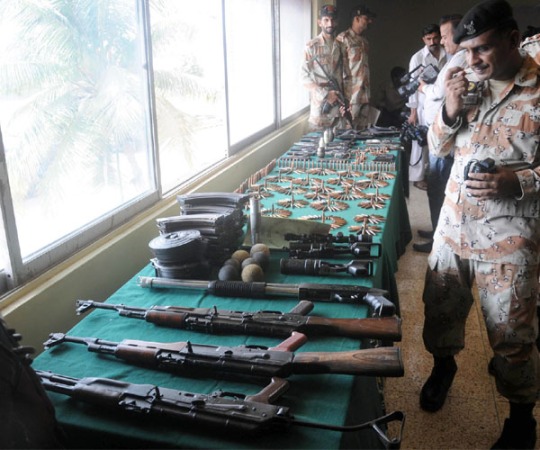
Ordinarily, Pakistan does not surprise me with the injustice that goes on in the country. I live in Karachi and am frighteningly used to instances of violence and bloodshed that the city is reputed for. The news, more or less every day, leaves me depressed, but for the past few days, my heart has been aching for what is going on in Karachi -- especially Lyari.
In four days, Lyari has seen the concentrated essence of what we call ‘Karachi violence’. Four were dead as of June 10 and 18 had been injured even before the sun set. With a TV screen as the sole connection between Lyari and the rest of Karachi right now, it is becoming next to impossible to watch the news and believe that a part of this very city is suffering the most arid kind of negligence from the authorities. Yes, Rangers and the Sindh Police have not even penetrated the area fully.
A “gang war” sprung between the Kutchi Rabita Committee (KRC) and a local rival group after a man called Arif Baloch was killed on Saturday in Kalri. The rival group claims that the KRC attacked Baloch. In reaction, “unidentified men” opened fire in Hingorabad, Lyari, injuring four KRC workers. The KRC denied the allegation of Baloch’s killing. This episode resulted in a series of cross-firing between the groups of Lyari.
[caption id="" align="alignnone" width="440" caption="Workers of Kachi Rabta Committee protesting against target killing in Lyari in Karachi. PHOTO: RASHID AJMERI"] [/caption]
[/caption]
The question here is who is really bearing the brunt of this clash the most?
It is the innocent residents of Lyari, who are helpless as they watch their children traumatised by the deafening roars of gunshots. They have run out of food and have had to risk their lives to get flour and rice.
[caption id="" align="alignnone" width="440" caption="People standing near the chairs after bomb blast in Lyari Karachi. PHOTO: ASHRAF MEMON"]
 [/caption]
Residents of Lyari, teary-eyed as they spoke, told the media that they plan to relocate (like many others who have) and pleaded with the perpetrators to stop this madness. They claim that although seven Rangers pickets had been set by the peace committee in the area, there were no Rangers in sight to help stop the bloodshed.
The residential buildings in Lyari are riddled with bullets. The walls, like the people, are brittle from being shot at and attacked by grenades. Children cannot go to school any more without risking their lives.
Even during the elections, Lyari was given minimal to no coverage. It is a well-populated area and deserves as much efficiency of the media and law enforcement as anywhere else. Had Lyari been highlighted like NA-250, perhaps we’d have made worse discoveries about rigging and injustice than we did.
Yesterday, one man died and 20 others were injured in Lyari. Thankfully, it earned some attention from Muttahida Quami Movement chief Altaf Hussain, who said that such activities are promoting hatred and that immediate action should be taken by the government.
[caption id="" align="alignnone" width="440" caption="People standing near the motor cycle which destroyed in bomb blast at Lyari Karachi. PHOTO: ASHRAF MEMON"]
[/caption]
Residents of Lyari, teary-eyed as they spoke, told the media that they plan to relocate (like many others who have) and pleaded with the perpetrators to stop this madness. They claim that although seven Rangers pickets had been set by the peace committee in the area, there were no Rangers in sight to help stop the bloodshed.
The residential buildings in Lyari are riddled with bullets. The walls, like the people, are brittle from being shot at and attacked by grenades. Children cannot go to school any more without risking their lives.
Even during the elections, Lyari was given minimal to no coverage. It is a well-populated area and deserves as much efficiency of the media and law enforcement as anywhere else. Had Lyari been highlighted like NA-250, perhaps we’d have made worse discoveries about rigging and injustice than we did.
Yesterday, one man died and 20 others were injured in Lyari. Thankfully, it earned some attention from Muttahida Quami Movement chief Altaf Hussain, who said that such activities are promoting hatred and that immediate action should be taken by the government.
[caption id="" align="alignnone" width="440" caption="People standing near the motor cycle which destroyed in bomb blast at Lyari Karachi. PHOTO: ASHRAF MEMON"] [/caption]
This area is a PPP stronghold and while PPP Sindh general secretary Taj Haider has condemned the attacks on civilians, I am sure the residents are looking forward to some action from them to put an end to their misery. Just using the word "condemn" to calm people down is not enough.
In its tenure, the PPP should have cleaned up Lyari of its drug, guns and extortion mafia. This says a lot about what lengths parties can go to for votes -- what lenience they can exhibit for support.
Let us not forget the rest of Karachi, which has been experiencing sporadic bursts of violence throughout it for the past half week. What have these people done to deserve this? Is this what Karachiites get for a political awakening? Does associating oneself with the ideology of a certain party deserve this blood-drenched fruition. Affiliation with a party is the midpoint in the process to realising one’s responsibilities as a citizen. Bullets are not what innocents deserve for living in a certain area where issues between parties and gangs cannot be sorted out.
[/caption]
This area is a PPP stronghold and while PPP Sindh general secretary Taj Haider has condemned the attacks on civilians, I am sure the residents are looking forward to some action from them to put an end to their misery. Just using the word "condemn" to calm people down is not enough.
In its tenure, the PPP should have cleaned up Lyari of its drug, guns and extortion mafia. This says a lot about what lengths parties can go to for votes -- what lenience they can exhibit for support.
Let us not forget the rest of Karachi, which has been experiencing sporadic bursts of violence throughout it for the past half week. What have these people done to deserve this? Is this what Karachiites get for a political awakening? Does associating oneself with the ideology of a certain party deserve this blood-drenched fruition. Affiliation with a party is the midpoint in the process to realising one’s responsibilities as a citizen. Bullets are not what innocents deserve for living in a certain area where issues between parties and gangs cannot be sorted out.
If grenades keep exploding and gunshots resonate in the city on daily basis, the snowball effect of this complete unrest may be something worse than we can handle – civil war.
I strongly urge the Sindh Police to own up to their responsibility and arrest these gangsters, who are also notorious for extortion and other crimes amongst other offences. 19 lives have already been lost as I write this.
The new government needs to address the citizens of Karachi, who are on the verge of losing their faith in any kind of system after having lost their loved ones to routine clashes. That is the least that can be done in this hour of need.
Read more by Imaan here or follow her on Twitter @SheikhImaan



 A protester throws a tear gas shell back towards security forces as they arrive for an operation in Lyari. Photo: Reuters[/caption]
Many people have been killed so far in the fresh round of violence, including innocent civilians. Apart from the killings, life in Lyari has come to a complete halt.
Children are agitated at not being able to go to school and play with friends.
Women beg their husbands, sons and brothers not to go to work.
Men are at a loss since their income has come to a standstill.
I recently returned to Lyari, for a couple of months after a year-long absence, and what struck me immediately was the complete lawlessness prevalent in the entire locality. I saw men, wandering around Lyari,
A protester throws a tear gas shell back towards security forces as they arrive for an operation in Lyari. Photo: Reuters[/caption]
Many people have been killed so far in the fresh round of violence, including innocent civilians. Apart from the killings, life in Lyari has come to a complete halt.
Children are agitated at not being able to go to school and play with friends.
Women beg their husbands, sons and brothers not to go to work.
Men are at a loss since their income has come to a standstill.
I recently returned to Lyari, for a couple of months after a year-long absence, and what struck me immediately was the complete lawlessness prevalent in the entire locality. I saw men, wandering around Lyari,  People gather after bomb blast during football match at Bazinjo Road in Sango Lane, Lyari. Photo: S. Imran Ali/PPI Images[/caption]
Ever since the murder of
People gather after bomb blast during football match at Bazinjo Road in Sango Lane, Lyari. Photo: S. Imran Ali/PPI Images[/caption]
Ever since the murder of  Pakistan Ranger personnel standing with weapons captured from Lyari: Photo: Muhammad Azeem[/caption]
It seems like the law enforcers have deliberately chosen to turn a blind eye to the violence, hoping that the gangsters will do their work for them. I think that their approach is that once one group eliminates another, they can deal with what’s left. In the meanwhile,
Pakistan Ranger personnel standing with weapons captured from Lyari: Photo: Muhammad Azeem[/caption]
It seems like the law enforcers have deliberately chosen to turn a blind eye to the violence, hoping that the gangsters will do their work for them. I think that their approach is that once one group eliminates another, they can deal with what’s left. In the meanwhile,  Arrested criminals and captured weapons lying in the custody of Pakistan Rangers after operation in Lyari. Photo: Rashid Ajmeri[/caption]
The worst part of it all is that no one seems to care.
No one so much as attempts to bring peace, no one empathises and absolutely no one considers the
Arrested criminals and captured weapons lying in the custody of Pakistan Rangers after operation in Lyari. Photo: Rashid Ajmeri[/caption]
The worst part of it all is that no one seems to care.
No one so much as attempts to bring peace, no one empathises and absolutely no one considers the 


 Day 2
Dear Diary,
Today was one of the best and worst days of my existence.
It was the worst because the bullets went sweeping past the windows, the gaps between those blasts became less frequent and the hurried movements of the gunmen shook the earth, the core of the neighbourhood trembled and the air echoed with gunfire.
I have
Day 2
Dear Diary,
Today was one of the best and worst days of my existence.
It was the worst because the bullets went sweeping past the windows, the gaps between those blasts became less frequent and the hurried movements of the gunmen shook the earth, the core of the neighbourhood trembled and the air echoed with gunfire.
I have 

 Photo: AFP[/caption]
Most of us have heard of areas in Lyari like Kalakot, Baghdadi, Chakiwara and the likes, due to the many operations that have taken place there, but rarely have we ever heard of Football Chowk, Usman Park, Gabol Park, Peoples Stadium, Lyari Football Ground, Eidgah Ground and many similar places.
At night, people gather at these grounds to watch the screening of the matches where big screens have been installed for people to come support their favourite teams in action. You get to see fans waving their favourite team’s flags, wearing jerseys of their favourite players with flags of their teams painted on their faces. One can say that they have a
Photo: AFP[/caption]
Most of us have heard of areas in Lyari like Kalakot, Baghdadi, Chakiwara and the likes, due to the many operations that have taken place there, but rarely have we ever heard of Football Chowk, Usman Park, Gabol Park, Peoples Stadium, Lyari Football Ground, Eidgah Ground and many similar places.
At night, people gather at these grounds to watch the screening of the matches where big screens have been installed for people to come support their favourite teams in action. You get to see fans waving their favourite team’s flags, wearing jerseys of their favourite players with flags of their teams painted on their faces. One can say that they have a  Photo: AFP[/caption]
Brazil is an all-time favourite there, with motorbikes, houses and offices covered in Brazil’s flags. Germany, Portugal and Argentina follow suit. In terms of players, Lionel Messi, Cristiano Ronaldo and Neymar are liked the most; so much so that you even see
Photo: AFP[/caption]
Brazil is an all-time favourite there, with motorbikes, houses and offices covered in Brazil’s flags. Germany, Portugal and Argentina follow suit. In terms of players, Lionel Messi, Cristiano Ronaldo and Neymar are liked the most; so much so that you even see  Photo: AFP[/caption]
The extent of their love for this sport can be judged by the fact that, even before the match
Photo: AFP[/caption]
The extent of their love for this sport can be judged by the fact that, even before the match  Photo: AFP[/caption]
This under-privileged and misunderstood area is amazingly talented. Not only in football but the people of Lyari are equally talented in other sports as well, like cricket, cycling, donkey cart race, karate, boxing and various others. One will find many sports clubs and gymnasiums that are operated without any government assistance, where sportsmen train themselves. That is the reason there are a whole lot
Photo: AFP[/caption]
This under-privileged and misunderstood area is amazingly talented. Not only in football but the people of Lyari are equally talented in other sports as well, like cricket, cycling, donkey cart race, karate, boxing and various others. One will find many sports clubs and gymnasiums that are operated without any government assistance, where sportsmen train themselves. That is the reason there are a whole lot  Photo: AFP[/caption]
I know that when you hear the word Lyari, the first few things to pop into your mind are civil war, thugs, gang wars, dangerous but this was my attempt to change the way Lyari is thought about. There are places and people who have hidden talents that don’t meet the eye, but if you search hard enough, you will realise that even a place like Lyari is gifted. It is so much more than just gang wars, guns and terrorism. Don’t believe me? Go see for yourself, visit the streets of the area and see how the people over there are full of life.
Read the original Urdu version of this blog
Photo: AFP[/caption]
I know that when you hear the word Lyari, the first few things to pop into your mind are civil war, thugs, gang wars, dangerous but this was my attempt to change the way Lyari is thought about. There are places and people who have hidden talents that don’t meet the eye, but if you search hard enough, you will realise that even a place like Lyari is gifted. It is so much more than just gang wars, guns and terrorism. Don’t believe me? Go see for yourself, visit the streets of the area and see how the people over there are full of life.
Read the original Urdu version of this blog 

 Photo: Shah official Facebook page[/caption]
Performance wise, I feel the movie solely rests on one man’s shoulders,
Photo: Shah official Facebook page[/caption]
Performance wise, I feel the movie solely rests on one man’s shoulders,  Photo: Shah official Facebook page[/caption]
Other than Sarwar, the other actor who manages to leave a mark on the audience is veteran
Photo: Shah official Facebook page[/caption]
Other than Sarwar, the other actor who manages to leave a mark on the audience is veteran  Photo: Shah official Facebook page[/caption]
[caption id="" align="alignnone" width="595"]
Photo: Shah official Facebook page[/caption]
[caption id="" align="alignnone" width="595"] Photo: Shah official Facebook page[/caption]
Shah sends the right message of pride, patriotism and aptly pays tribute to the great Shah. Unfortunately, the film does have its flaws and lacks quality and aesthetics in other departments.
For instance, the editing by Tahir Ali seems to be the weakest part of the movie. Similarly, cinematography by Omar Daraz and Hassan Zaidi is nothing to write home about. This could be due to the fact that the team had an extremely
Photo: Shah official Facebook page[/caption]
Shah sends the right message of pride, patriotism and aptly pays tribute to the great Shah. Unfortunately, the film does have its flaws and lacks quality and aesthetics in other departments.
For instance, the editing by Tahir Ali seems to be the weakest part of the movie. Similarly, cinematography by Omar Daraz and Hassan Zaidi is nothing to write home about. This could be due to the fact that the team had an extremely  Photo: Shah official Facebook page[/caption]
Overall, even though the message of the movie was very strong, it lacked the finishing touches required to make a film go all the way.
I would rate Shah a 2.5 out of five.
Photo: Shah official Facebook page[/caption]
Overall, even though the message of the movie was very strong, it lacked the finishing touches required to make a film go all the way.
I would rate Shah a 2.5 out of five.






